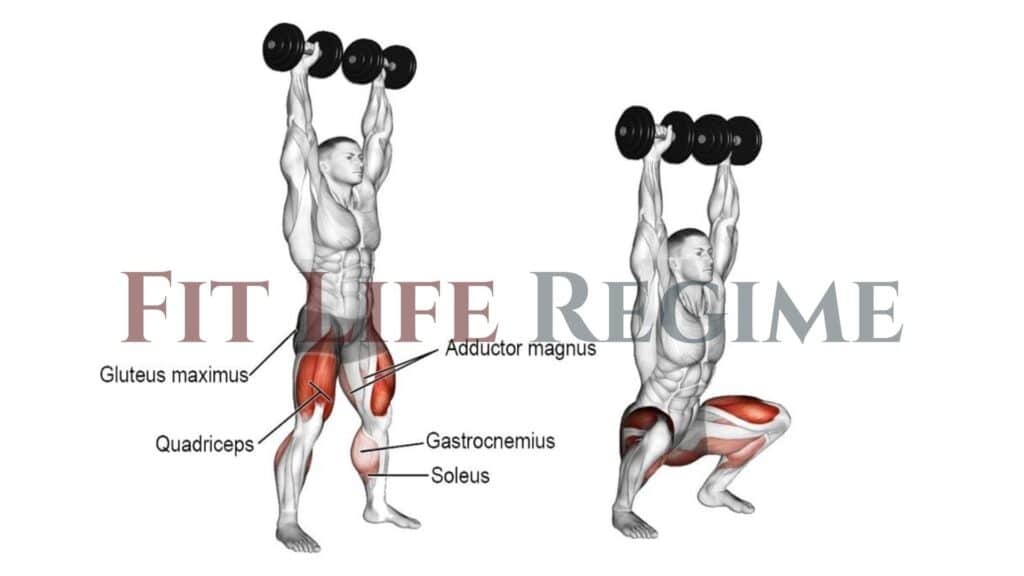The overhead dumbbell squat is a compound exercise that combines both a squat and an overhead press. It simultaneously works for multiple muscle groups. Thus, it gives you a full-body workout in one move.
The overhead squat significantly activates the core, shoulder quadriceps, glutes, and hamstrings. It’s a relatively advanced exercise that demands more mobility and stability than a standard squat.
It helps you build balance, flexibility, mobility, and improve your proprioception and coordination.
Know More: Dumbbell Leg Exercises To Mass And Strength

Dumbbell Overhead Squat Muscles Worked
The dumbbell overhead squat is a compound exercise that targets multiple muscle groups.
The primary muscles worked during this exercise include:
Other muscles also play a role in overall stability.

How To Do Both Arm Dumbbell Overhead Squat
- Stand with your feet shoulder-width apart and hold a dumbbell in each hand right above your shoulders.
- Your palms should be facing forward, and your elbows should be almost fully extended.
- Keep your elbows slightly soft, not locked. Maintain a straight spine with a slight arch in your lower back.
- Lower your body into a squat position by bending your knees and pushing your hips back as if sitting back in a chair.
- Keep the dumbbells directly over your shoulders throughout the squat movement.
- Now raise yourself up using only the thigh power.
- Do 8–10 reps and 3–4 sets.
Tips and Form
- Keep your torso upright, shoulders back, head up, and feet flat.
- During the move, keep your back straight, your knees aligned with your toes, and your chest up.
- Avoid rounding your back or letting your knees collapse inward.
- Start with light weights until you master proper form and balance.
- Make sure that your toes and knees are pointing in the same direction.
- Descend until your thighs are parallel to the ground (or as low as your mobility allows) without compromising your form.
- Inhale as you lower into the squat position and exhale as you push through your heels to return to the starting position
- Before performing the overhead dumbbell squat, make sure to warm up your legs, core, and upper body with dynamic stretching and light cardio exercises.
- It’s much better to use very light dumbbells with a full-depth, balanced squat than heavier dumbbells that are unstable in a partial-depth squat.
Related Post: 10 Best Dumbbell Quad Exercises To Build Mass And Strength
Single Arm Dumbbell Overhead Squat
Once you’ve mastered the basic overhead dumbbell squat, you can try some advanced variations to add variety and challenge to your workout:
- Single Arm Overhead Dumbbell Squat
- Overhead Dumbbell Squat with Press
The single-arm overhead dumbbell squat is a challenging variation of the squat exercise. It focuses on unilateral strength, stability, and core engagement.
In this exercise, you hold a dumbbell overhead with one arm while performing the squat movement.
It takes balance and coordination to maintain form during the exercise.
How To Do Single-Arm Dumbbell Overhead Squats
- Stand with your feet shoulder-width apart.
- Grip a dumbbell in one hand and extend it directly overhead.
- The dumbbell should be in line with or slightly behind your head.
- Be sure to keep your chest upright and your eyes forward.
- As you inhale, initiate the squat by bending your knees and pushing your hips back.
- Lower your body down by flexing your hips and knees while keeping the dumbbell overhead.
- Aim to lower yourself until your thighs parallel the ground or slightly below.
- Exhale and push through your heels to extend your knees and hips, returning to the starting position.
- Repeat the movement for the desired number of repetitions,
- Then, switch the dumbbell to the opposite hand and repeat on the other side.
FAQs
Is the overhead dumbbell squat suitable for beginners?
The overhead dumbbell squat is an advanced move that requires strength, balance, and coordination. Beginners should start with lighter weights and focus on proper form and technique before adding weight.
Why are overhead squats so hard?
An overhead squat requires significant mobility and stability. Specifically, you need ample mobility—ankle, hip, spinal, and shoulder—to get into the position. From there, it takes strength to maintain the exercise’s stability.
Can the overhead dumbbell squat help me lose weight?
Yes, the overhead dumbbell squat is a high-intensity exercise that can burn calories and aid in weight loss when combined with a balanced diet and regular exercise.

Manish is a NASM-certified fitness and nutrition coach with over 10 years of experience in weight lifting and fat loss fitness coaching. He specializes in gym-based training and has a lot of knowledge about exercise, lifting technique, biomechanics, and more.
Through “Fit Life Regime,” he generously shares the insights he’s gained over a decade in the field. His goal is to equip others with the knowledge to start their own fitness journey.
